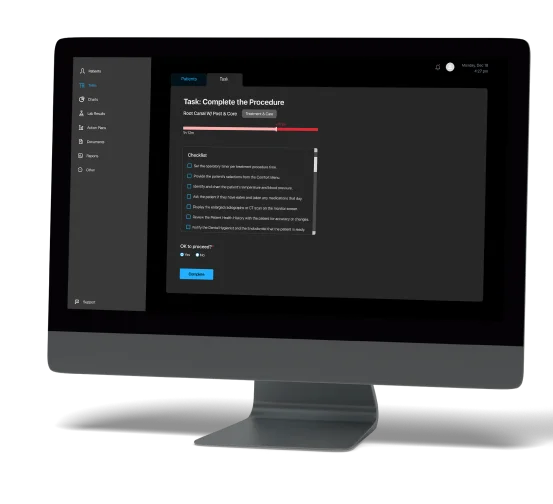CASE STUDY
ERP solution for a dentist clinic
Discover how custom software let this business target a new pool of clients and cut costs within the organization.
Tech stack/tools we used: Camunda, BPMN, Java, React, Azure, Jira, Teams

- 34%
reduction in manual work
- 48%
decrease in human errors
- 1000+
satisfied patients
Client
A US-based dental clinic banks on software to improve service and reduce expenses
A dental clinic reached out to Syberry to build BPA software that would help the business grow, reduce expenses, and attract new clients. The owner hoped to automate all client-oriented business processes, such as patient registration, treatment, aftercare and more.
Problem
Human errors hurt the clinic's reputation
The client struggled with providing 5-star service because of regular, unavoidable human error. Hiring and training experienced staff wasn't enough to prevent all mishaps, and if just one out of a hundred patients left a bad review, it undermined the clinic's reputation.
Solution
Business process automation (BPA) software transforms patient care
In a strategic move to enhance service quality while trimming operational costs, the dental clinic partnered with Syberry to implement custom BPA software. The goal was to streamline and automate the entire patient care cycle, spanning from visit registration to aftercare and payment. Syberry delivered a user-friendly web application, integrating metrics, checklists, and guidelines at every step to empower medical professionals and eliminate the possibility of human error.
Automated processes include:
Challenge #1
Implementing Serverless Architecture
At the beginning of the project, the customer expressed a preference for serverless architecture. However, early on, the team recognized challenges with the combination of Azure functions and the Java Spring Boot Framework. The primary concerns revolved around UI response time and instant messaging, crucial aspects for the project's success. To illustrate these challenges, we implemented a Proof of Concept (PoC) to showcase the limitations and potential drawbacks of the initial system constraint.
Challenge #2
Transitioning to Docker containers with Java Spring Boot
In response to the identified constraints of serverless architecture, our team and the customer decided together to transition from the initial infrastructure to a solution utilizing Docker Containers with Java Spring Boot. This revised approach not only addressed the UI and instant messaging concerns but also aligned seamlessly with the overall functionality and specific use cases of the project.
Succeed faster with Syberry
If you submit a request today, your MVP will be ready
as early as January 11, 2026
Key features
Multi-Tenant Infrastructure
The application aligns with HIPAA standards by incorporating a multi-tenant approach ensuring robust data protection. This guarantees that each clinic using the software stores its data in a separate, secure infrastructure.
Task Timers with Target Metrics
To optimize efficiency, each task within the automated process is equipped with a timer indicating the target completion time. Dynamic time bars and color-coded indicators resulted in a remarkable 11% increase in task processing speed for medical personnel.
Process Dashboard
A comprehensive dashboard provides clinic administrators with real-time insights into every patient's current treatment stage. Colorful modules intuitively signal areas requiring attention, enabling administrators to focus on critical aspects and track improvements.
The outcome
A blueprint other franchises and clinics can use to enhance their own practices
YOU MIGHT ALSO BE INTERESTED IN...

Compliance, Technology
Ethical compliance system
This startup successfully attracted Fortune 100 clients and got acquired by a prominent ethical compliance organization.

Technology
Sales management software for a mobile device reseller
Custom software let this client adapt to the changing market conditions and focus on business growth.

Technology, ERP
ERP system for a technology company
Explore how a single platform let this tech company improve efficiency in HR, sales, accounting, and production.

Technology
Online call recording application
Discover how Syberry transformed a client's vision into a leading call recording solution with over 300,000 users.
Succeed faster with Syberry
If you submit a request today, your MVP will be ready
as early as January 11, 2026